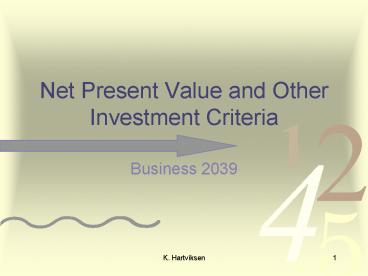Net Present Value and Other Investment Criteria - PowerPoint PPT Presentation
1 / 26
Title:
Net Present Value and Other Investment Criteria
Description:
Net Present Value and Other Investment Criteria Business 2039 1 K. Hartviksen ... IRR Example IRR Example IRR vs. NPV Both methods use the same basic decision inputs. – PowerPoint PPT presentation
Number of Views:168
Avg rating:3.0/5.0
Title: Net Present Value and Other Investment Criteria
1
Net Present Value and Other Investment Criteria
- Business 2039
1
K. Hartviksen
2
This Chapter - Topics
- Net Present Value
- Payback Period
- Discounted Payback
- Average Accounting Return
- Internal Rate of Return
- Multiple IRRs
- Mutually Exclusive Investments (NPV vs. IRR)
- Profitability Index
- capital rationing
2
K. Hartviksen
3
Long-Term Investments
- When a firm considers a new project, corporate
acquisition, plant expansion or asset acquisition
that will produce income over the course of many
yearsthis is called capital budgeting. - It is imperative that in the analysis of such
projects that we consider the timing, riskiness
and magnitude of the incremental, after-tax
cashflows that the project is expected to
generate for the firm.
4
Payback Method
- This is a simple approach to capital budgeting
that is designed to tell you how many years it
will take to recover the initial investment. - It is often used by financial managers as one of
a set of investment screens, because it gives the
manager an intuitive sense of the projects risk.
5
Payback Example
6
Discounted Payback Example
7
Discounted Payback Graphed
NPV
Discounted Payback Point
Years
8
Discounted Payback
- Overcomes the lack of consideration of the time
value of money - can help us see the pattern of cashflows beyond
the payback point. - If carried to the end of the projects useful
lifewill tell us the projects NPV (if you are
using the firms WACC)
9
Net Present Value
- NPV -PV of initial cost PV of incremental
after-tax benefits - if greater than 0 - accept
- if equal to 0 - indifferent
- if less than 0 - reject
10
Firms Cost of Capital
- At this point in the course, you will be given
the firms cost of capital - the firms cost of capital determines the minimum
rate of return that would be acceptable for a
capital project. - The weighted average cost of capital (WACC) is
the relevant discount rate for NPV analysis.
11
NPV Example
12
NPV Example
13
NPV Example
14
NPV Example
15
NPV Example
16
NPV Example
17
NPV Example
18
NPV Profile
NPV
IRR
0
Discount Rate
19
NPV Profiles
- The slope of the NPV profile depends on the
timing and magnitude of cashflows. - Projects with cashflows that occur late in the
projects life will have an NPV that is more
sensitive to discount rate changes.
20
IRR
- The internal rate of return (IRR) is that
discount rate that causes the NPV of the project
to equal zero. - If IRR gt WACC, then the project is acceptable
because it will return a rate of return on
invested capital that is likely to be greater
than the cost of funds used to invest in the
project.
21
IRR Example
22
IRR Example
23
IRR vs. NPV
- Both methods use the same basic decision inputs.
- The only difference is the assumed discount rate.
- The IRR assumes intermediate cashflows are
reinvested at IRRNPV assumes they are reinvested
at WACC
24
NPV Profile
NPV
IRR(B)
IRR(A)
0
Discount Rate
25
Profitability Index
- Uses exactly the same decision inputs as NPV
- simply expresses the relative profitability of
the projects incremental after-tax cashflow
benefits as a ratio to the projects initial
cost. - PI PV of incremental ATCF benefits
- PV of initial cost of project
- If PIgt1, then we accept because the PV of
benefits exceeds the PV of costs.
26
Capital Rationing
- The corporate practice of limiting the amount of
funds dedicated to capital investments in any one
year. - Is academically illogical.
- In the long-run could threaten a firms
continuing existence through erosion of its
competitive position.































![Federal return on investment [cumulative dollar amount of assistance disbursements to systems divided by cumulative Federal outlays for projects] provided by the Drinking Water Safe Revolving Fund (DWSRF). PowerPoint PPT Presentation](https://s3.amazonaws.com/images.powershow.com/7259019.th0.jpg?_=20151013085)